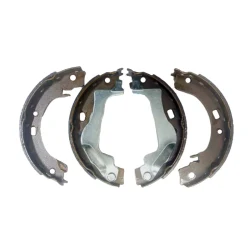What Are Brake Shoes?
2024-05-30
Brake shoes are an essential component of drum brake systems, commonly found on the rear wheels of many vehicles. Here's a detailed look at brake shoes and their role in a braking system:
What Are Brake Shoes?
Brake shoes are curved friction plates that press against the inside of a brake drum to create friction, slowing down or stopping the vehicle. They are typically made of a steel backing plate with a high-friction material bonded or riveted to it.
Components of a Brake Shoe System
1. Brake Shoes: The primary component that applies pressure to the brake drum.
2. Brake Drums: The cylindrical component that rotates with the wheel. The brake shoes press against the inner surface of the drum.
3. Wheel Cylinders: Hydraulic cylinders that push the brake shoes outward against the brake drum when the brake pedal is pressed.
4. Return Springs: These springs retract the brake shoes away from the drum when the brake pedal is released.
5. Adjuster Mechanism: Maintains the correct distance between the brake shoes and the drum as the friction material wears down over time.
How Brake Shoes Work
1. Activation: When the brake pedal is pressed, brake fluid from the master cylinder flows into the wheel cylinder.
2. Expansion: The wheel cylinder's pistons push the brake shoes outward.
3. Friction: The friction material on the brake shoes contacts the inner surface of the brake drum, creating friction and slowing the wheel.
4. Release: When the brake pedal is released, the return springs pull the brake shoes back to their resting position, away from the drum.
Types of Brake Shoes
1. Leading-Trailing Shoe Configuration: This is the most common type in which one shoe (the leading shoe) does most of the work when moving forward, and the other shoe (the trailing shoe) assists.
2. Twin Leading Shoe Configuration: Found mostly in front drum brakes of older vehicles, where both shoes are leading, providing better braking efficiency.
Maintenance and Replacement
- Wear Inspection: Brake shoes should be inspected regularly for wear. The friction material should not be less than 1.5 mm thick.
- Replacement: Replace brake shoes in pairs (both wheels on the same axle) to ensure balanced braking.
- Cleaning: Keep the brake assembly clean and free from dust and debris. Avoid using compressed air as brake dust can be harmful if inhaled.
Signs That Brake Shoes Need Replacement
1. Noise: Squealing or grinding noises when braking can indicate worn brake shoes.
2. Reduced Braking Efficiency: If the brakes feel less effective or require more pressure to engage, the brake shoes might be worn out.
3. Uneven Braking: Pulling to one side during braking can indicate uneven wear on the brake shoes.
4. Vibration: Vibration in the brake pedal or steering wheel during braking can also signal issues with the brake shoes.
Tips for Brake Shoe Replacement
- Safety First: Always work on the vehicle on a flat, stable surface and use jack stands to support the vehicle.
- Proper Tools: Use the correct tools to avoid damaging components.
- Reference Manual: Refer to the vehicle's service manual for specific instructions and torque specifications.
- Check All Components: Inspect and replace other related components like return springs and the adjuster mechanism if they show signs of wear.
Brake shoes play a critical role in vehicle safety, and regular maintenance is key to ensuring reliable braking performance.



